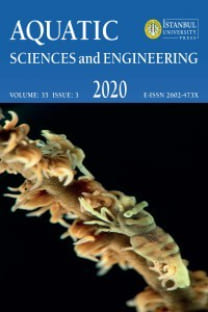crangon)
MINERAL AND HEAVY METAL CONTENTS OF WARTY CRAB (Eriphia verrucosa) AND BROWN SHRIMP (Crangon crangon)
T race elements, Minerals, Crab Brown shrimp,
___
- Anonymous, (2002). Working group on Crangon fisheries and life history. ICES CM 2001/G:10, Ref: ACFM,B. 54 p.
- Anonymous, (2003). 4950 Number fisheries act. 29.7.2003 date, 25183 number official gazette.
- Anonymous, (2010). http://www.fao.org/docrep/field/003/ab470e/ab470e06.htm
- AOAC. (1998). Official method 955.04. Total nitrogen in seafood. Chapter 35, p.6. Fish and other marine products. James M. Hungerford. Chapter Editor. Official methods of analysis of AOAC International. Edited by Patrica Cunniff. AOAC,
- http://img.21food.cn/img/biaozhun/20100108/177/11285281.pdf Graphite oven method, 999,10.
- Bat, L., Oztürk, M., (1997). Heavy metal levels in some organisms from the Sinop Peninsula of the Black Sea, Turkish Journal of Engineering and Environmental Sciences, 21(1), 29-33.
- Canlı, M., Ay, O., Kalay, M., (1988). Levels of heavy metals (Cd, Pb, Cu, Cr and Ni) in tissue of Cyprinus carpio, Barbus capito and Chondrostoma regium from the Seyhan River, Turkey. Turkish Journal of Zoology, 22, 149-15.
- Debaka, R., McKenzie, A.D., Forsyth, D.S., Conacher, H.B.S., (2004). Survey of total mercury in some edible fish and shellfish species collected in Canada in 2002. Food Additives and Contaminants, 21(5), 434-440. EPA,
- http://www3.epa.gov/epawaste/hazard/testmethods/sw846/pdfs/7061a.pdf AAS Official Method 7061A. EPA,
- http://www3.epa.gov/epawaste/hazard/testmethods/sw846/pdfs/7471b.pdf AAS Official Method 7471A.
- FAO/WHO, (1986). Food Contamination and Monitoring Programme for Codex, Comitee of Food Addives. WHO/EHE/FOS/86.
- Gibson, R.N., (1994). Impact of habitat quality and quantity on the recruitment of juvenile flatfishes. Netherlands Journal of Sea Research, 32, 191-206.
- Gökoğlu, N., Yerlikaya, P., Gökoğlu, M., (2008). Trace elements in edible tissues of three shrimp species (Penaeus semisulcatus, Parapenaeus longirostris and Paleomon serratus). Journal of the Science of Food and Agriculture, 88, 175–178.
- Hashmi, M.I., Mustafa, S., Tarig, S.A., (2002). Heavy metal concentrations in water and tiger prawn (Penaeus monodon) from grow-out farms in Sabah, North Borneo. Food Chemistry, 79, 151-156.
- Horrocks, L.A., Yeo, Y.K., (1999). Health benefits of docosahexaenoic acid (DHA). Pharmacological Research, 40, 3, 211-225.
- Kalay, M. and Karataş, S., (1999). Kadmiyumun Tilapia nilotica (L.)’da kas, beyin ve kemik (omurga kemiği) dokularındaki birikimi. Turkish Journal of Zoology, 23, (Ek Sayı 3), 985-991.
- Knowles, T.G., Farrington, D., Kestin, S.C., (2003). Mercury in UK imported fish and shellfish and UK- farmed fish and their products. Food Additives and Contaminants, 20(9), 813-818.
- Kücükgülmez, A., Celik, M., Yanar, Y., Ersoy, B., Cıkrıkcı, M., (2006). Proximate composition and mineral contents of the blue crab (Callinectes sapidus) breast meat, claw meat and hepatopancreas. International Journal of Food Science and Technology, 41, 1023-1026.
- Matta, J., Milad, M., Mange,r R., osteson, T., (1999). Heavy metals, lipid peroxidation, and cigateratoxicity in the liver of the Caribben barracuda (Sphyraena barracuda). Biological Trace Element Research, 70, 69-79.
- Marx, H., Brunner, B., (1998). Heavy metal contamination of North Sea shrimp (Crangon crangon L.). Zeitschrift für Lebensmittel-Untersuchung und –Forschung, 207, 273-275.
- Sivaperumal, P., Sankar, T.V., Viswanathan-Nair, P.G., (2007). Heavy metal concentrations in fish, shellfish and fish products from internal markets of India vis-a-vis international standards. Food Chemistry, 102, 612-620.
- Soundarapandian, P., Varadharajan, D., Sivasubramanian, C., (2013). Mineral Composition of Edible Crab, Charybdis natator Herbst (Crustacea: Decapoda). Journal of Bioanalysis & Biomedicine, 5-4, 99-101.
- Sümbüloğlu, K., Sümbüloğlu, V., (2000). Biyoistatistik. Hatipoğlu Press 53, p 269, Ankara.
- Yazkan, M., Özdemir, F., Gölükçü, M., (2004). Cu, Zn, Pb and Cd Contents in Some Molluscs and Crustacea Caught in the Gulf of Antalya. Turkish Journal of Veterinary and Animal Sciences, 28, 95-100.
- Yılmaz, A.B., Yılmaz, L., (2007). Influences of sex and seasons on levels of heavy metals in tissues of green tiger shrimp (Penaeus semisulcatus de Hann, 1844). Food Chemistry, 101, 1664-1669.
- Yayın Aralığı: Yılda 4 Sayı
- Başlangıç: 1987
- Yayıncı: İstanbul Üniversitesi
A BRIEF OVERVIEW ON CRYOPRESERVATION METHOD OF STURGEON SPERM
Güneş YAMANER, Aygül EKİCİ, Gökhan TUNÇELLİ, Devrim MEMİŞ
Türkiye Cumhuriyeti’nin İkinci Sanayi Planı(1936)’nda Mersin Balıklarının Yeri ve Önemi
Serap USTAOĞLU TIRIL, Devrim MEMİŞ
